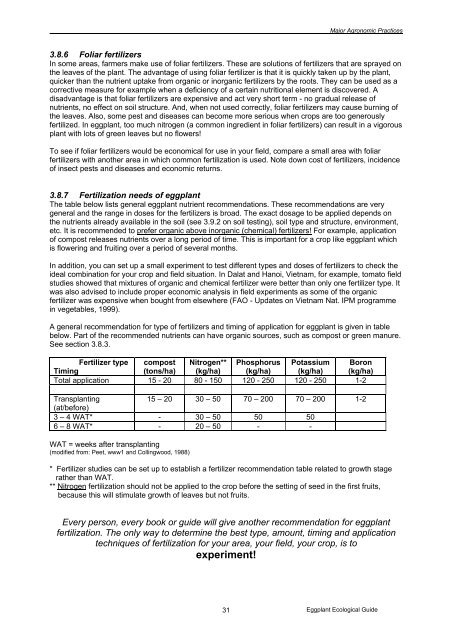Eggplant Integrated Pest Management AN ECOLOGICAL GUIDE
Eggplant Integrated Pest Management AN ECOLOGICAL GUIDE
Eggplant Integrated Pest Management AN ECOLOGICAL GUIDE
Create successful ePaper yourself
Turn your PDF publications into a flip-book with our unique Google optimized e-Paper software.
___________________________________________________________________________________Major Agronomic Practices3.8.6 Foliar fertilizersIn some areas, farmers make use of foliar fertilizers. These are solutions of fertilizers that are sprayed onthe leaves of the plant. The advantage of using foliar fertilizer is that it is quickly taken up by the plant,quicker than the nutrient uptake from organic or inorganic fertilizers by the roots. They can be used as acorrective measure for example when a deficiency of a certain nutritional element is discovered. Adisadvantage is that foliar fertilizers are expensive and act very short term - no gradual release ofnutrients, no effect on soil structure. And, when not used correctly, foliar fertilizers may cause burning ofthe leaves. Also, some pest and diseases can become more serious when crops are too generouslyfertilized. In eggplant, too much nitrogen (a common ingredient in foliar fertilizers) can result in a vigorousplant with lots of green leaves but no flowers!To see if foliar fertilizers would be economical for use in your field, compare a small area with foliarfertilizers with another area in which common fertilization is used. Note down cost of fertilizers, incidenceof insect pests and diseases and economic returns.3.8.7 Fertilization needs of eggplantThe table below lists general eggplant nutrient recommendations. These recommendations are verygeneral and the range in doses for the fertilizers is broad. The exact dosage to be applied depends onthe nutrients already available in the soil (see 3.9.2 on soil testing), soil type and structure, environment,etc. It is recommended to prefer organic above inorganic (chemical) fertilizers! For example, applicationof compost releases nutrients over a long period of time. This is important for a crop like eggplant whichis flowering and fruiting over a period of several months.In addition, you can set up a small experiment to test different types and doses of fertilizers to check theideal combination for your crop and field situation. In Dalat and Hanoi, Vietnam, for example, tomato fieldstudies showed that mixtures of organic and chemical fertilizer were better than only one fertilizer type. Itwas also advised to include proper economic analysis in field experiments as some of the organicfertilizer was expensive when bought from elsewhere (FAO - Updates on Vietnam Nat. IPM programmein vegetables, 1999).A general recommendation for type of fertilizers and timing of application for eggplant is given in tablebelow. Part of the recommended nutrients can have organic sources, such as compost or green manure.See section 3.8.3.Fertilizer type compost Nitrogen** Phosphorus Potassium BoronTiming(tons/ha) (kg/ha) (kg/ha) (kg/ha) (kg/ha)Total application 15 - 20 80 - 150 120 - 250 120 - 250 1-2Transplanting15 – 20 30 – 50 70 – 200 70 – 200 1-2(at/before)3 – 4 WAT* - 30 – 50 50 506 – 8 WAT* - 20 – 50 - -WAT = weeks after transplanting(modified from: Peet, www1 and Collingwood, 1988)* Fertilizer studies can be set up to establish a fertilizer recommendation table related to growth stagerather than WAT.** Nitrogen fertilization should not be applied to the crop before the setting of seed in the first fruits,because this will stimulate growth of leaves but not fruits.Every person, every book or guide will give another recommendation for eggplantfertilization. The only way to determine the best type, amount, timing and applicationtechniques of fertilization for your area, your field, your crop, is toexperiment!31<strong>Eggplant</strong> Ecological Guide




![Section 4 [ PDF file, 252 KB] - The Field Alliance](https://img.yumpu.com/51387260/1/158x260/section-4-pdf-file-252-kb-the-field-alliance.jpg?quality=85)











